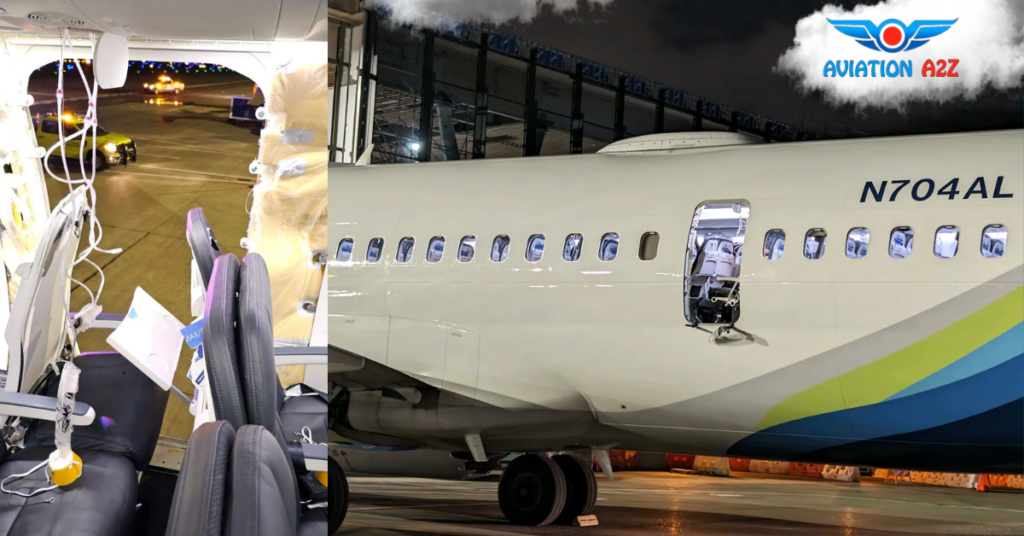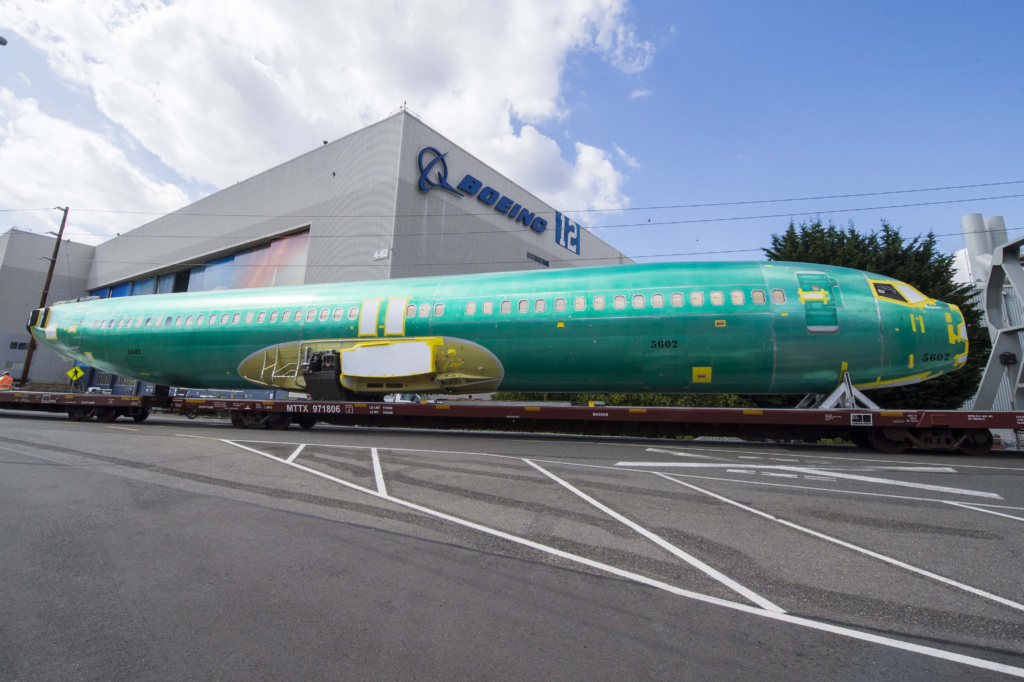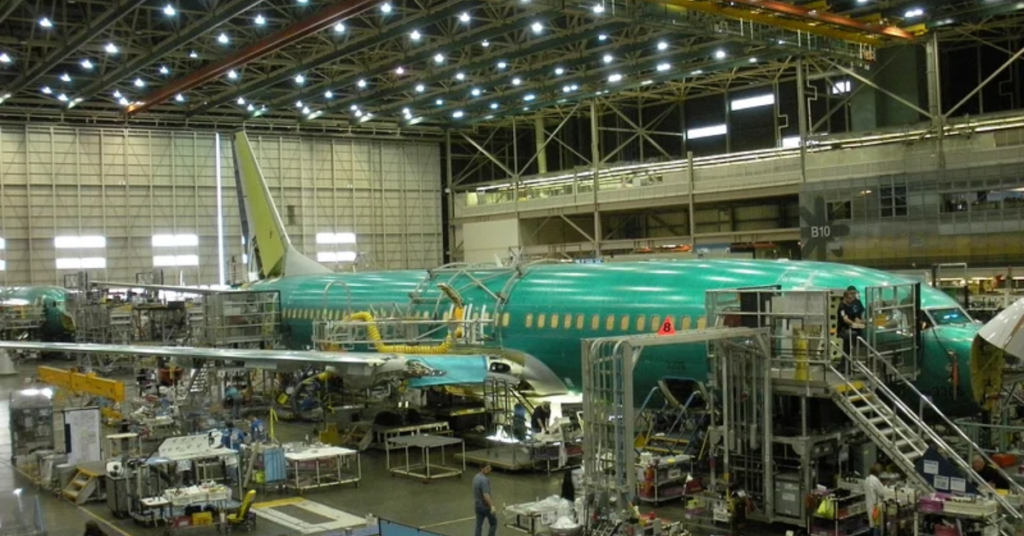RENTON- The Alaska Airlines (AS) Boeing 737 MAX 9 (737-9) jet that experienced a fuselage panel detachment earlier this month had the panel removed for repair and was subsequently incorrectly reinstalled by Boeing mechanics on the Renton final assembly line, according to a source familiar with the matter.
If confirmed by the National Transportation Safety Board (NTSB) investigation, Boeing would be primarily held responsible for the incident, shifting blame from the original supplier, Spirit AeroSystems.

Boeing 737 MAX 9 Fuselage Panel Mis-Installed
The detached panel, a door plug designed to seal a fuselage hole, caused a concerning event during Alaska Airlines Flight 1282.
An anonymous whistleblower on the Leehamnews site with access to Boeing’s manufacturing records revealed additional details, pointing to a lack of proper installation of bolts crucial for pressurization loads.
The whistleblower criticized Boeing’s quality control and safety culture, emphasizing lapses in the inspection process in Renton. The NTSB had previously raised concerns about the possibility of missing bolts.
The whistleblower highlighted a failure in the inspection process due to a flawed recording system, describing Boeing’s 737 production system as a potential disaster. The accuracy of this account can be verified through the ongoing investigation.

Horrifying Incident
Passengers aboard Flight 1282 experienced severe trauma when a door-sized section of the 737 MAX 9 fuselage explosively detached at 16,000 feet over Portland. The blown-out door plug, designed to seal a fuselage cutout for an optional emergency exit, is often inconspicuous to passengers.
The incident has proven to be a significant setback for Boeing, drawing global outrage and mockery. With the MAX 9 fleet grounded for almost three weeks, the CEOs of Alaska and United sharply criticized Boeing, expressing frustration and disappointment.
The whistleblower, who remains anonymous, detailed online how a mis-installed door plug caused the incident, pointing to systemic failures in Boeing’s quality control and recording processes.
The whistleblower’s account has been corroborated by industry experts and insiders, highlighting concerns about Boeing’s corporate culture and the need for decisive action to address cultural issues at the executive level.

Error in Tracking System
The online whistleblower outlined two tracking systems employed by Boeing to monitor the multitude of tasks involved in assembling aircraft. The error arose when a task was discussed in one system but not fully documented in the other.
The first system, known as the Common Manufacturing Execution System (CMES), serves as the formal record for the FAA, capturing every completed job during airplane construction. Conversely, the Situation Action Tracker (SAT) is an informal messaging board within the Boeing factory utilized by mechanics, engineers, and management to highlight issues.
A Renton mechanic, speaking anonymously to safeguard their job, explained the use of SAT to address defects and garner additional attention to problems. The whistleblower noted a concerning frequency of defects produced by Spirit, Boeing’s supplier.
Boeing’s records from the past year reportedly indicate 392 nonconforming findings at the location where the door plug is installed. These findings encompass both MAXs with actual emergency doors and those, like the Alaska jet, with permanent plugs.
On the aircraft, later identified as Alaska Airlines Flight 1282, discrepancies were initially found on the right-side door plug on Aug. 31, not the one that eventually blew out on the left. Subsequent inspection revealed “damaged and improperly installed rivets” on the left door plug, documented in both CMES and SAT.
A repair was conducted by the Spirit team, documented in the SAT message thread. Still, a Boeing inspector recorded in CMES that the repair was inadequate, accusing the Spirit team of merely covering up the defects. This prompted a reopening of the repair job.
Upon reevaluation, Spirit Mechanics identified additional issues with the pressure seal between the plug and the airframe, necessitating replacement.
The whistleblower emphasized the significance of this seal and noted that the required replacement part was unavailable in Renton, potentially jeopardizing the jet’s delivery schedule.

Lack of Experience
This intensifies the urgency of the repair process. The whistleblower highlighted an entry in the SAT system revealing discussions between Boeing and Spirit teams about whether the door plug needed complete removal or just opening.
Crucially, full removal of the door plug, or even just opening it, mandates documentation in CMES and formal approval from a quality inspector to ensure compliance with regulatory standards after reinstallation.
However, a decision was made to merely open the door without recording a formal removal entry in CMES, leading to the absence of an inspection. The whistleblower labeled this a “major process failure.” Essentially, the essential bolts were removed, and there was no subsequent inspection to confirm their proper reinsertion.
The whistleblower did not explicitly identify who conducted the removal and reinstallation of the door plugin Renton. Still, information from another source familiar with the repair suggested it was Boeing mechanics.
The entire work sequence, including the damaged rivets and pressure seal, was documented in SAT, while CMES recorded the issues but lacked mention of the removal and reinstallation process.
Critical procedural errors, particularly the failure to accurately document the work and the remaining tasks for completion, seem to reflect what former MAX assembly manager Pierson termed “manufacturing chaos” witnessed in 2018. This chaos arose when mechanics were pressured to accelerate work to meet tight schedules, leading to a lack of communication between shifts.
Apart from the quality control process shortcomings, Boeing employees pointed to labor turnover during the COVID-19 pandemic as a significant factor. A veteran machinist in Renton expressed concern about wage competition hindering Boeing’s ability to replace experienced personnel who left during the pandemic.
Another mechanic noted the hiring of individuals with minimal to no experience working on such aircraft, replacing seasoned machinists with over 20 years of experience.
In the closing remarks of the online post, the whistleblower raised a critical question: “So, where are the bolts?” Speculating, the whistleblower suggested they might be forgotten and unlabeled on a work-in-progress bench or possibly discarded in a scrap bin for cleanup.
Stay tuned with us. Further, follow us on social media for the latest updates.
Join us on Telegram Group for the Latest Aviation Updates. Subsequently, follow us on Google News.

